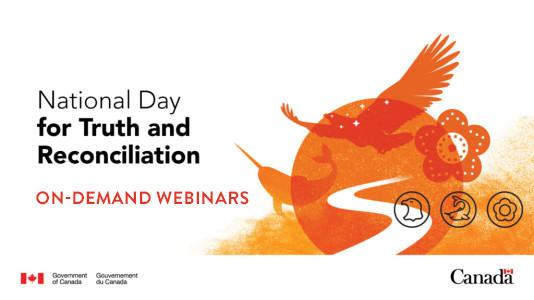
Join us in the first of two webinars commemorating the 2023 National Day for Truth and Reconciliation.
NOW AVAILABLE ON-DEMAND
The RAIC is grateful for and honours the generosity of the members of the RAIC Truth and Reconciliation Task Force and Indigenous Task Force. The RAIC is committed to continued action along this journey together.

Part One: History and Context
Free for everyone.
Description
Each year, September 30 marks the National Day for Truth and Reconciliation.
The day honours the children who never returned home and Survivors of residential schools, as well as their families and communities. Public commemoration of the tragic and painful history and ongoing impacts of residential schools is a vital component of the reconciliation process. This is an Indigenous-led session that will explore important historical facts leading to the National Day for Truth and Reconciliation.
Learning Objectives
By the end of this session, participants will be able to describe:
1. The impact of the Indian Act on First Nations;
2. The history, intent and impact of Residential and Day Schools;
3. How the Residential School system caused intergenerational trauma; and
4. The purpose of the Truth and Reconciliation Commission of Canada Calls to Action.
Meet the Presenters
Naomi Ratte
Naomi Ratte is a consultant and intern landscape architect at NVision. She is a member of Peguis First Nation and has a passion for empowering Indigenous communities through landscape planning and design. She completed both the Bachelor of Environmental Design and Master of Landscape Architecture Program at the University of Manitoba. Her graduate research focused on exploring Indigenous stories of occupation and connections to the land. Naomi has worked on a variety of projects with Indigenous communities across Canada. Some of the projects are related to Land Use Planning, Design, Master and Management Planning, Interpretive Planning and Historic Site Conservation Planning. Naomi is currently the co-chair of the Canadian Society of Landscape Architects Reconciliation Advisory Committee.
Elder Susan Tatoosh
Susan Tatoosh is a respected elder and mentor who, as Executive Director of the Vancouver Friendship Society, is credited with significant improvements to programing and services for the urban Indigenous community and helping some of the most marginalized populations.
Of Shuswap ancestry and a member of the Hupacaseth First Nation from Vancouver Island, Tatoosh has dedicated her life to working with people, bringing her leadership, governance, planning and management skills to the boards of almost every urban Indigenous organization in Vancouver. She was instrumental in moving the homeless shelter from the basement and gym of the Friendship Centre to a permanent, well-managed shelter space in the Downtown Eastside. She is also working with the City of Vancouver to construct a second shelter.
She also worked with the City of Vancouver on the Dialogue Project to bring together Indigenous people and new immigrants to build understanding between cultures and alleviate discrimination and racism.
As chair of the Aboriginal Community Career Employment Services Society (ACCESS), she worked with the BC Construction Association to create opportunities for Indigenous people. As a founding member of Urban Spirit Foundation, she assists urban Indigenous people to upgrade their education, find jobs and improve their earning power.
Earlier in her career, Tatoosh ran the first outreach program for native women in Canada.
In the 1980s, Elder Tatoosh moved to Vancouver and worked for Urban Images for Native Women, an employment training organization. She also worked on the federal strategy to increase the economic participation of Indigenous people living in urban centres.
Simoogit Saa Bax Patrick R. Stewart, PhD, Architect AIBC, NCARB, FRAIC
Patrick Stewart is a member of the Killerwhale House of Daaxan of the Nisga’a Nation. He has operated his firm, Patrick R. Stewart Architect, for 26 years. Patrick was the first architect of First Nations ancestry in B.C. to own and operate an architectural firm in B.C. (1995) and the first person of First Nations ancestry elected as President of the Architectural Institute of British Columbia (2005-2007). He has chaired the Royal Architectural Institute of Canada (RAIC) Indigenous Task Force since 2015 and has co-chaired the RAIC Truth and Reconciliation Task Force since 2019. Patrick has also chaired the Provincial Aboriginal Homelessness Committee in B.C. since 2005.
He is an alumnus of Simon Fraser University (BA), Dalhousie University (BEDS, BArch), McGill University (MArch) and University of British Columbia (PhD). Patrick is also an Adjunct Professor at the McEwen School of Architecture at Laurentian University, Sudbury, Ont. He has had the privilege to be a co-editor of Our Voices: Indigeneity and Architecture (2018) and Our Voices II: the decolonial project (2021), both published by ORO Editions. Currently, he is the lead editor for the forthcoming book, Our Voices III: catalysts for change (2022) to also be published by ORO Editions.
It is important to Patrick to always give back to community, whether it is within his Nation, the architectural profession or those less fortunate. Having been born homeless and growing up in care, Patrick has never taken anything for granted. He continues to push the boundaries and look to the future.



